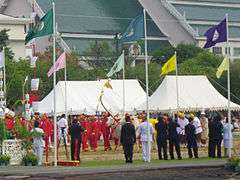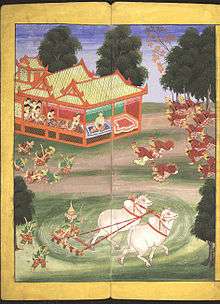Royal Ploughing Ceremony
| Royal Ploughing Ceremony | |
|---|---|
 Royal Ploughing Ceremony in Bangkok, Thailand (2009) | |
| Official name |
|
| Also called | Farmer's Day |
| Observed by | Thais or Cambodians |
| Type | National in the Kingdom of Thailand and the Kingdom of Cambodia |
| Significance | Marks the beginning of the rice growing season |
| Observances | Ploughing |
| Date |
Hora determination (Thailand) 4th day of the 6th lunar month's waning moon (Cambodia)[1] |
| 2015 date |
13 May (Thailand) 6 May (Cambodia) |
| 2016 date |
9 May (Thailand) 24 May (Cambodia) |
| 2017 date |
12 May (Thailand) 14 May (Cambodia) |
| 2018 date | 3 May (Cambodia) |
| Related to | Royal Ploughing Ceremony |
The Royal Ploughing Ceremony (Khmer: ព្រះរាជពិធីបុណ្យច្រត់ព្រះនង្គ័ល Preah Reach Pithi Chrot Preah Neangkol; Thai: พระราชพิธีจรดพระนังคัลแรกนาขวัญ Phra Ratcha Phithi Charot Phra Nangkhan Raek Na Khwan) is an ancient royal rite held in many Asian countries to mark the traditional beginning of the rice growing season. The royal ploughing ceremony, called Lehtun Mingala (လယ်ထွန်မင်္ဂလာ, pronounced: [lɛ̀tʰʊ̀ɴ mɪ̀ɴɡəlà]) or Mingala Ledaw (မင်္ဂလာလယ်တော်), was also practiced in pre-colonial Burma until 1885 when the monarchy was abolished.
Thai names
In Thailand, the common name of the ceremony is Raek Na Khwan (แรกนาขวัญ) which literally means the "auspicious beginning of the rice growing season". The royal ceremony is called Phra Ratcha Phithi Charot Phra Nangkhan Raek Na Khwan (พระราชพิธีจรดพระนังคัลแรกนาขวัญ) which literally means the "royal ploughing ceremony marking the auspicious beginning of the rice growing season".[2]
This Raek Na Khwan ceremony is of Hindu origin. Thailand also observes another Buddhist ceremony called Phuetcha Mongkhon (พืชมงคล) which literally means "prosperity for plantation". The royal ceremony is called Phra Ratcha Phithi Phuetcha Mongkhon (พระราชพิธีพืชมงคล).[3] The official translation of Phuetcha Mongkhon is "Harvest Festival".[4]
King Mongkut combined both the Buddhist and Hindu ceremonies into a single royal ceremony called Phra Ratcha Phithi Phuetcha Mongkhon Charot Phra Nangkhan Raek Na Khwan (พระราชพิธีพืชมงคลจรดพระนังคัลแรกนาขวัญ). The Buddhist part is conducted in the Grand Palace first and is followed by the Hindu part held at Sanam Luang, Bangkok.[5]
At present, the day on which Phra Ratcha Phithi Phuetcha Mongkhon Charot Phra Nangkhan Raek Na Khwan is held is called Phuetcha Mongkhon Day (วันพืชมงคล Wan Phuetcha Mongkhon). It has been a public holiday since 1957.[4]
Date

The traditional date of the Burmese royal ploughing ceremony was the beginning of the Buddhist lent in the Burmese month of Waso (June to July).[6]
In 2009, the ceremony was held on May 11 in Thailand and on May 12 in Cambodia. The date is usually in May, but varies as it is determined by Hora (astrology) (Khmer: ហោរាសាស្រ្ត, hourasastr; Thai: โหราศาสตร์, horasat). In 2013, the ceremony and public holiday was held on Monday, 13 May.[7] In Cambodia, the ceremony is mostly held on a Tuesday or Saturday.
In Thailand, the exact date and times for the yearly event are set annually by Brahman priests. Discontinued by the 1920s, this practice was revived beginning in 1960.
Rituals
In the ceremony, two sacred oxen are hitched to a wooden plough and they plough a furrow in some ceremonial ground, while rice seed is sown by court Brahmins. After the ploughing, the oxen are offered plates of food, including rice, corn, green beans, sesame, fresh-cut grass, water and rice whisky.

Depending on what the oxen eat, court astrologers and Brahmins make a prediction on whether the coming growing season will be bountiful or not. The ceremony is rooted in Brahman belief, and is held to ensure a good harvest. In the case of the Burmese royal ploughing ceremony, it may also have Buddhist associations. In traditional accounts of the Buddha's life, Prince Siddhartha, as an infant, performed his first miracle during a royal ploughing ceremony, by meditating underneath a rose apple tree (ဇမ္ဗုသပြေ), thus exemplifying his precocious nature.[8]
Burmese chronicles traditionally attribute the start of this rite to the late 500s CE during the Pagan dynasty, when it was performed by the kings Htuntaik, Htunpyit and Htunchit, all of whom bear the name 'htun' or 'plow.'[8] However, this costly ritual did not occur annually nor was it performed by every monarch.[8] During this ritual, the king plowed a specifically designated field outside the royal palace called the ledawgyi (လယ်တော်ကြီး) with white oxen that were adorned with golden and silver, followed by princes and ministers, who took turns to ceremonially plow the fields.[9] While the plowing was undertaken, Brahmin priests offered prayers and offerings to the 15 Hindu deities, while a group of nat votaries and votaresses (နတ်ဆရာ, နတ်အုပ်, နတ်စော) invoked the 37 chief nats (indigenous spirits).[9] The ploughing ceremony was a ritual to propitiate the rain god, Moe Khaung Kyawzwa (မိုးခေါင်ကျော်စွာ) in order to ensure a good harvest for the kingdom, and also a way for the king to present himself as a peasant king (တောင်သူကြီးမင်း) to the commoners.[8]
In Thailand, the rite dates back to the Sukhothai Kingdom (1238–1438). During John Crawfurd's Siam mission, he noted on 27 April 1822 (near the end of the reign of Rama II)
This was a day of some celebrity in the Siamese calendar, being that on which the kings of Siam, in former times, were wont to hold the plough, like the Emperors of China,[note 1] wither as a religious ceremony, or as an example of agricultural industry to their subjects. This rite has long fallen into disuse, and given place to one which, to say the least of it, is of less dignity... A Siamese...who had often witnessed it, gave me the following description:—A person is chosen for this occasion to represent the King. This monarch of a day is known by the name of Piya-Pun-li-teb, or King of the Husbandmen. He stands in the midst of a rice-field, on one foot only, it being incumbent on him to continue in this uneasy attitude during the time that a common peasant takes in ploughing once around him in a circle. Dropping the other foot, until the circle is completed, is looked upon as a most unlucky omen; and the penalty to the "King of the Husbandmen" is said to be not only the loss of his ephemeral dignity, but also of his permanent rank, what ever that may be, with what is more serious—the confiscation of his property. The nominal authority of this person lasts from morning to night. During the whole of this day the shops are shut; nothing is allowed to be bought or sold; and whatever is disposed of, in contravention of the interdict, is forfeited, and becomes the perquisite of the King of the Husbandmen following the ploughing. Specimens of all the principal fruits of the earth are collected together in a field, and an ox is turned loose amongst them, and the particular product which he selects to feed upon, is, on the authority of this experiment, to be considered as the scarcest fruit of the ensuing season, and therefore entitled to the especial care of the husbandman.[10]
Series 2 banknotes first issued in 1925 during the reign of Rama VI and continuing into the reign of Rama VII depicted the Royal Ploughing Ceremony on the backs of all six denominations.[11] Rama VII discontinued the practice in the 1920s, to be revived in 1960 by Rama IX, King Bhumibol Adulyadej.[12][13]
In both Cambodia and Thailand, the ceremony is typically presided over by the monarch, or an appointee. Sometimes the monarch himself has taken part in the ceremony and actually guided the plough behind the oxen.
In recent years in Thailand, Crown Prince Maha Vajiralongkorn has presided over the ceremony, which is held at Sanam Luang in Bangkok. Rice grown on the Chitralada Palace grounds, home of King Bhumibol Adulyadej is sown in the ceremony, and afterward, onlookers swarm the field to gather the seed, which is believed to be auspicious.
In Cambodia, both King Norodom Sihamoni and Prime Minister Hun Sen have overseen the rite.
Japan
One of the duties of the Emperor of Japan as chief Shinto priest is the ritualistic planting of the first rice seed in a paddy on the grounds of the Tokyo Imperial Palace. He is also the one who performs the ritualistic first harvest.[14][15]
See also
- Plough Monday, traditional start of the English agricultural year
Notes
- ↑ "China" (wiki). based on Encyclopaedia Americana 1851 edition. Agepedia. 3 November 2007. Retrieved 10 February 2012.
Every year, on the 15th day of the first moon, the emperor repairs, in great state, to a certain field, accompanied by the princes and the principal officers, prostrates himself, and touches the ground nine times with his head, in honor of Tien, the God of heaven; he pronounces a prayer prepared by the court of ceremonies, invoking the blessing of the Great Being on his labor and that of his people. Then, as the highpriest of the empire, he sacrifices a bullock to heaven, as the fountain of all good. Whilst the victim is offered on the altar, a plough, drawn by a pair of oxen, highly ornamented, is brought to the emperor, who throws aside his imperial robes, lays hold of the handle of the plough, and opens several furrows over the whole field.
References
- ↑ "The Royal Ploughing Ceremony 2011". Tourism Cambodia. Ministry of Tourism, Cambodia. Retrieved 18 July 2011.
- ↑ "Royal Institute Dictionary 1999" (in Thai). Bangkok: Royal Institute of Thailand. 2007. Retrieved 2014-05-09.
แรกนา, แรกนาขวัญ น. ชื่อพิธีเริ่มไถนา, ถ้าทําเป็นทางราชการ เรียกว่า พระราชพิธีจรดพระนังคัลแรกนาขวัญ, แต่โดยทั่วไปมักเรียกว่า พระราชพิธีแรกนา หรือ พระราชพิธีแรกนาขวัญ
- ↑ "Royal Institute Dictionary 1999" (in Thai). Bangkok: Royal Institute of Thailand. 2007. Retrieved 2014-05-09.
พืชมงคล [พืดชะ, พืด] น. ชื่อพระราชพิธีที่พระสงฆ์สวดเพื่อความเจริญของพืชพันธุ์ธัญญาหาร เรียกว่า พระราชพิธีพืชมงคล เป็นพระราชพิธีที่ทำก่อนพระราชพิธีจรดพระนังคัลแรกนาขวัญ ซึ่งเป็นพิธีพราหมณ์.
- 1 2 ประกาศสำนักคณะรัฐมนตรี เรื่อง กำหนดเวลาทำงานและวันหยุดราชการ (ฉบับที่ 11) พ.ศ. 2500 [Announcement of the Office of the Prime Minister on Determination of Working Hours and Public Holidays (No. 11), BE 2500 (1957)] (pdf). Government Gazette (in Thai). Bangkok: Cabinet Secretary (Volume 74, Part 88): 2466. 1957-10-15. Retrieved 2014-05-09.
- ↑ ประวัติพระราชพิธีมงคลจรดพระนังคัลแรกนาขวัญ [History of the Royal Ploughing Ceremony] (in Thai). Ministry of Agriculture and Cooperatives. n.d. Retrieved 2014-05-09.
- ↑ Nisbet, John (1901). Burma under British rule--and before. University of Michigan Press. p. 333.
- ↑ "Royal Ploughing Ceremony - Chiang Mai Best". Retrieved 13 May 2013.
- 1 2 3 4 Khin Maung Nyunt (July 1997). "Lehtun Mingala (The Royal Ploughing Ceremony)". Myanmar Perspectives. 3 (7). Archived from the original on October 6, 1999.
- 1 2 Hardiman, John Percy (1900). Gazetteer of Upper Burma and the Shan States. 2. Government of Burma. p. 101.
- ↑ Crawfurd, John (21 August 2006) [1830]. "V. —Annual Ceremony of the King's holding the plough.". Journal of an Embassy from the Governor-general of India to the Courts of Siam and Cochin China. 1 (second ed.). London: H. Colburn and R. Bentley. pp. 207–209. OCLC 03452414. Retrieved February 13, 2012.
April 27.
- ↑ "Banknotes, Series 2". Banknotes > History and Series of Banknotes >. Bank of Thailand. February 23, 2012.
The design was printed on both sides....
- ↑ Ancient rituals for a bountiful harvest, TAT News, retrieved 2007-5-10
- ↑ Abundant crops expected in Thailand in 2007, Thai News Agency, MCOT, 2007-5-10
- ↑ http://kanakoskitchen.com/2009/10/20/gohan/
- ↑ http://spice.stanford.edu/docs/145
External links
| Wikimedia Commons has media related to Royal Ploughing Ceremony. |
- The Royal Ploughing Ceremony
- Tourism Cambodia Highlights: Ploughing Festival
- Dr. S. Green (28 October 2009). "Singai Empire" (blogspot). Sri Lankan Tamil rulers. Retrieved 11 February 2012.
King Vairamuthu ... inaugurates the food production by ploughing the paddy field.